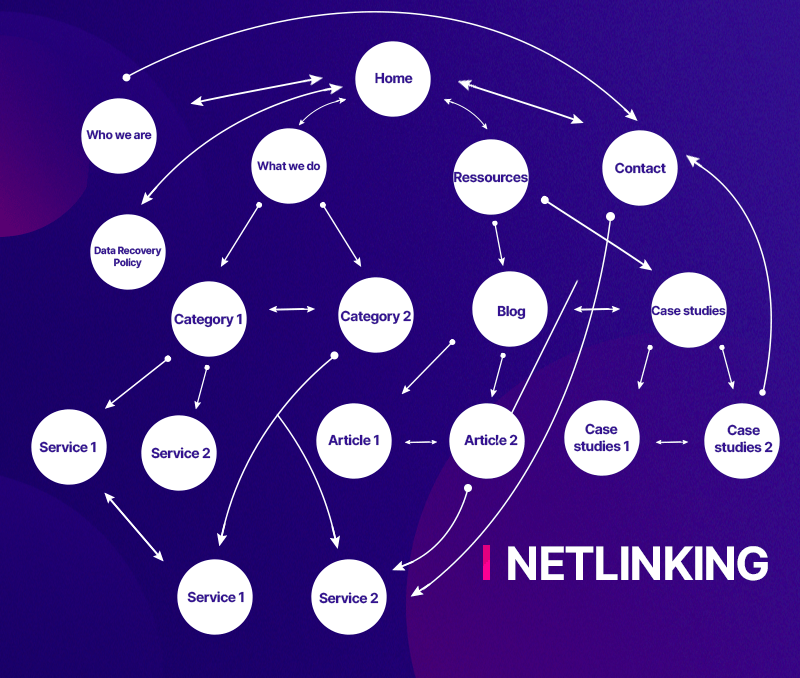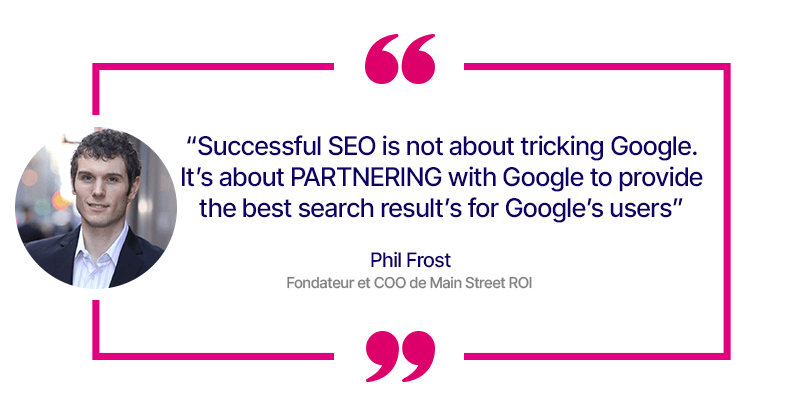One of the major challenges for marketing teams is to ensure that their content is not only well-ranked in search engines but also meets the needs of their audiences, to foster the organic ranking of their business. This is the whole challenge of Google Helpful Content SEO, Google’s algorithm that relies on users’ search intent to offer them the most relevant content possible.
In this article, we will explain what Google Helpful Content SEO is, its impact on your current content, and we will give you practical advice to optimize your online content, always focusing on the expectations of your visitors.
What is Google Helpful Content SEO?
Google Helpful Content SEO is a content-focused strategy aimed at optimizing a website’s positioning on search engines by creating useful and relevant content for users.
It involves going beyond just keywords and focusing on meeting the needs of visitors. Google’s goal is to provide search results that precisely answer users’ queries.
However, Google does not just focus on pages independently to assess a site’s quality but looks at the website as a whole. The Helpful Content Update algorithm is sitewide: if pages are deemed of poor quality, then the entire site can be impacted, even if it contains very good pages.
What is the purpose of the Google Helpful Content Update algorithm?
The Google Helpful Content Update (HCU) algorithm aims to prioritize publications that add real value to readers. An approach focused on Google Helpful Content SEO aims to improve the visibility of your website in Google’s search results while providing a quality user experience.
By creating content that answers questions, matches search intentions, and therefore meets the expectations of your audience, you increase your chances of ranking high in organic search results and consequently retaining your visitors.
If your visitors are satisfied, Google will be satisfied and will therefore improve your positioning.
On the contrary, if visitors do not find the information they are looking for, your site can be penalized. This can be noticeable in terms of the bounce rate or the time spent on your site, for example. The algorithm can identify low-quality content with little added value, which is not helpful for internet users in their searches.
Key Dates…
The rollout of HCU (Helpful Content Update) began on August 25, 2022, and concluded on September 9, 2022, initially affecting only English-language pages. The second phase, spanning from December 5, 2022, to mid-January, extended to content in all languages.
In September 2023, Google updated its documentation to include advice in three areas:
- Relaxation of rules related to content generated by artificial intelligence, which is now tolerated.
- Clarifications on hosting third-party content on subdomains (or the main domain) that negatively affect the overall relevance and quality of the website.
- Additional advice on what to do if your site loses traffic: lack of expertise, “false” content refreshment or merely updated dates.
How Does Google Evaluate Your Website?
As previously discussed, Google assesses the relevance and usefulness of your content during its evaluation, as well as the technical performance of your website.
Quality Content Fosters Visitor Satisfaction
Efforts should focus on the relevance of your content in relation to internet users’ queries.
- Content Quality: Your content must be targeted at the questions posed by your target audience. It’s also beneficial to look at related searches. You can use tools like Semrush, Answer the Public, or directly check frequently asked questions on Google.
- Keyword Relevance: Precisely identify the keywords and long-tail expressions used by internet users in their searches.
- Page Structure: Its construction should allow quick access to information related to the search intent and facilitate the reading of its content and/or navigation to other complementary pages.
The more effectively your content meets user needs, the greater its chances of achieving a high ranking.
Good Technical Performance Enhances User Experience
Although technical SEO is not taken into account by the Helpful Content algorithm, smooth, intuitive, and enjoyable navigation contributes to satisfaction, as it impacts the time spent on your site.
In addition to creating quality content, ensure that your website is technically optimized, with:
- Fast loading speed: through the choice of your hosting provider, reducing the size of your multimedia content, or using a Content Delivery Network (CDN).
- A responsive site: suitable for navigation on smartphones.
- Secure navigation: guaranteeing privacy, compliance with GDPR, and a secure site.
- Effective link building: by creating a logical and balanced internal linking structure, with quality backlinks.
You can also use HTML tags judiciously to help search engines understand the content of your pages.
How to Create Content That is Useful and Appreciated by Search Engines like Google?
The answer is relatively straightforward: put yourself in the shoes of the internet user to provide a clear answer to their questions and search queries. You need to position yourself as a “problem solver” to satisfy them.
Here are the main steps to offer useful and effective content:
Step 1. Understanding the Current User Journey
Analyze your users’ navigation on GA4 in the “User Flow” section to visualize their behavior on your site and identify potential optimization points, based on their bounce rate, time spent per page, exit page, etc.

It is very interesting to visualize the journey of your visitors in parallel using heatmap tools, such as Hotjar or Lucky Orange, on both mobile and desktop. You can observe their navigation and see potential areas for improvement on your pages.
Tip:
Study the terms searched in the search bar to identify missing content that may lead to frustration and early abandonment of your site.
Step 2. Studying the Target Audience
Conduct thorough research on your target audience and identify:
- their needs and frequent questions,
- their problems,
- the lexicon they use,
- the websites they visit.
By understanding them, you will be better able to offer content that precisely meets their expectations.
Step 3. Researching Keywords and Phrases
Use Google Ads Keyword Planner or another tool like Semrush to find impactful keywords and phrases based on demand volumes. This will inform you about the vocabulary commonly used in search intentions.
Show empathy by using the right titles (anchors) and meta descriptions, putting yourself in the place of your visitors and customers to use the terms they commonly use. You can then formulate these as questions or typical lists, for example, which will be an asset for Google Voice Search.
What is relevant for your targets will also become relevant for Google!
Step 4. Creating and Optimizing Content
You can then move on to the content creation phase, paying particular attention to:
- Developing informative, accurate, and reliable content that clearly answers the questions posed by users.
- Using relevant keywords that you have identified, but in a natural way, integrating them organically into your content.
- Placing the answer to your visitors’ queries at the top of your page to prevent bouncing, especially if scrolling takes too long to find the sought-after information. This can encourage them to continue reading.
- Creating added value compared to the contents of your competitors.
- Structuring your content, offering a clickable index to enhance accessibility and understanding of your articles.
- Providing visual contents to accompany your written content: photos, infographics, videos, and audios, not forgetting the Alt tag, so they appear in Google Images or Video searches.
- Ensuring that your content is easily accessible on all devices, including mobiles.
Advice:
Third-party contents should be deindexed if they are not consistent with the rest of the website, to avoid degrading your positioning.
We recommend removing low-value and unhelpful content to prevent them from penalizing your site as a whole.
Step 5. Effective Internal Linking
Focus on link building by creating or modifying links between pages on your website. This way, you can increase the pages viewed per session through complementary content, while facilitating the navigation of robots (crawling).
Google Search Console will allow you to see which pages are under- or overrepresented with links, enabling you to better distribute and balance them. It’s also the perfect opportunity to check if any links are broken.

Encourage quality backlinks by sharing your content on social networks and collaborating with other relevant websites.
Step 6. SEO Monitoring and Tracking
Continuously analyze your SEO performance to ensure that you do not lose your positioning. If necessary, you can react quickly and make optimizations to your content.
Tip:
If you are hesitant about making changes to your pages, don’t hesitate to check if your competitors have made changes to their site, based on:
- the use of SEO tools like Semrush, Ahrefs, and Moz to see changes in traffic, such as drops in traffic
- and the visualization of their site before/after using the Way Back Machine tool, to understand the points that may have degraded their ranking and the corrections made.
Conclusion
Google Helpful Content SEO is an essential approach for improving the visibility of your website while offering a quality user experience. By creating useful and relevant content focused on the questions of your audience, you will generate satisfaction and positively impact your organic ranking.
Google regularly updates its algorithm to improve the relevance of search results, which means that you need to continuously update your knowledge of its changes and adapt accordingly.
Our agency Eminence continuously monitors SEO best practices and the latest digital trends. Do you have a project and need advice?


